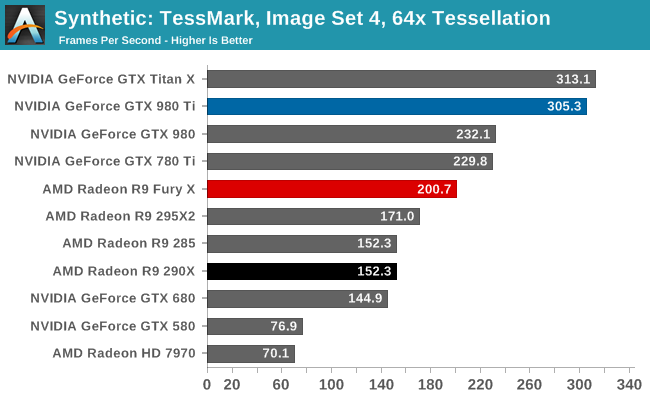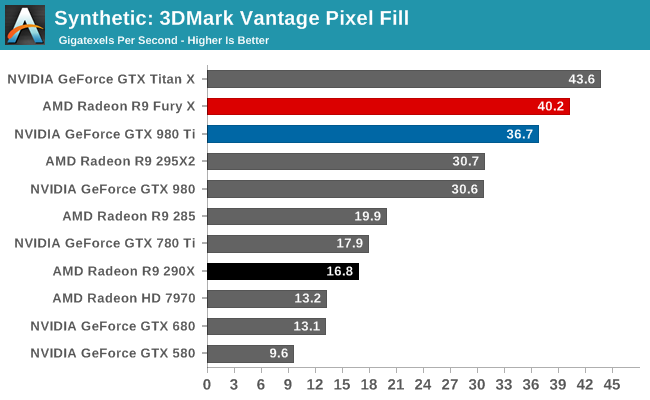The AMD Radeon R9 Fury X Review: Aiming For the Top
by Ryan Smith on July 2, 2015 11:15 AM ESTSynthetics
As always we’ll also take a quick look at synthetic performance. Since Fiji is based on the same GCN 1.2 architecture as Tonga (R9 285), we are not expecting too much new here.

First off we have tessellation performance. As we discussed in greater detail in our look at Fiji’s architecture, AMD has made some tessellation/geometry optimizations in GCN 1.2, and then went above and beyond that for Fiji. As a result tessellation performance on the R9 Fury X is even between than the R9 285 and the R9 290X, improving by about 33% in the case of TessMark. This is the best performing AMD product to date, besting even the R9 295X2. However AMD still won’t quite catch up to NVIDIA for the time being.

As for texture fillrates, the performance here is outstanding, though not unexpected. R9 Fury X has 256 texture units, the most of any single GPU card, and this increased texture fillrate is exactly in line with the theoretical predictions based on the increased number of texture units.

Finally, the 3DMark Vantage pixel fillrate test is not surprising, but it is none the less a solid and important outcome for AMD. Thanks to their delta frame buffer compression technology, they see the same kind of massive pixel fillrate improvements here as we saw on the R9 285 last year, and NVIDIA’s Maxwell 2 series. At this point R9 Fury X’s ROPs are pushing more than 40 billion pixels per second, a better than 2x improvement over the R9 290X despite the identical ROP count, and an important reminder of the potential impact of the combination of compression and HBM’s very high memory bandwidth. AMD’s ROPs are reaching efficiency levels simply not attainable before.










458 Comments
View All Comments
chizow - Thursday, July 2, 2015 - link
What about geometry Ryan? ROPs are often used interchangeably with Geometry/Set-up engine, there is definitely something going on with Fury X at lower resolutions, in instances where SP performance is no problem, it just can't draw/fill pixels fast enough and performs VERY similarly to previous gen or weaker cards (290X/390X and 980). TechReport actually has quite a few theoreticals that show this, where their pixel fill is way behind GM200 and much closer to Hawaii/GM204.extide - Thursday, July 2, 2015 - link
Yeah my bet is on Geometry. Check out the Synthetics page. It own the Pixel and Texel fillrate tests, but loses on the Tessellation test which has a large dependency on geometry. nVidia has also been historically very strong with geometry.CajunArson - Thursday, July 2, 2015 - link
Thanks for the review! While the conclusions aren't really any different than all the other reputable review sites on the Interwebs, you were very thorough and brought an interesting perspective to the table too. Better late than never!NikosD - Thursday, July 2, 2015 - link
You must use the latest nightly build of LAV filters, in order to be able to use the 4K H.264 DXVA decoder of AMD cards.All previous builds fall back to SW mode.
tynopik - Thursday, July 2, 2015 - link
"today’s launch of the Fiji GPU"andychow - Thursday, July 2, 2015 - link
Best review ever. Worth the wait. Get sick more often!tynopik - Thursday, July 2, 2015 - link
pg 2 - compression taking palcelimitedaccess - Thursday, July 2, 2015 - link
Ryan, regarding Mantle performance back in the R9 285 review (http://www.anandtech.com/show/8460/amd-radeon-r9-2... you wrote that AMD stated the issue with performance regression was that developers had not yet optimized for Tonga's newer architecture. While here you state that the performance regression is due to AMD having not optimized on the driver side. What is the actual case? What is the actual weighting given these three categories? -Hardware Driver
API
Software/Game
What I'm wondering is if we make an assumption that upcoming low level APIs will have similar behavior as Mantle what will happen going forward as more GPU architectures are introduced and newer games are introduced? If the onus shifts especially heavily towards the software side it it seems more realistic in practice that developers will have much more narrower scope in which optimize for.
I'm wondering if Anandtech could possibly look more indept into this issue as to how it pertains to the move towards low level APIs used in the future as it could have large implications in terms of the software/hardware support relationship going forward.
Ryan Smith - Thursday, July 2, 2015 - link
"What is the actual case? What is the actual weighting given these three categories? -"Right now the ball appears to be solidly in AMD's court. They are taking responsibility for the poor performance of certain Mantle titles on R9 Fury X.
As it stands I hesitate to read into this too much for DX12/Vulkan. Those are going to be finalized, widely supported APIs, unlike Mantle which has gone from production to retirement in the span of just over a year.
limitedaccess - Thursday, July 2, 2015 - link
Thanks for the response. I guess we will see more for certain as time moves on.My concern is if lower level APIs require more architecture specific optimizations and the burden is shifted to developers in practice that will cause some rather "interesting" implications.
Also what would be of interest is how much of reviewers test suites will still look at DX11 performance as a possible fallback should this become a possible issue.